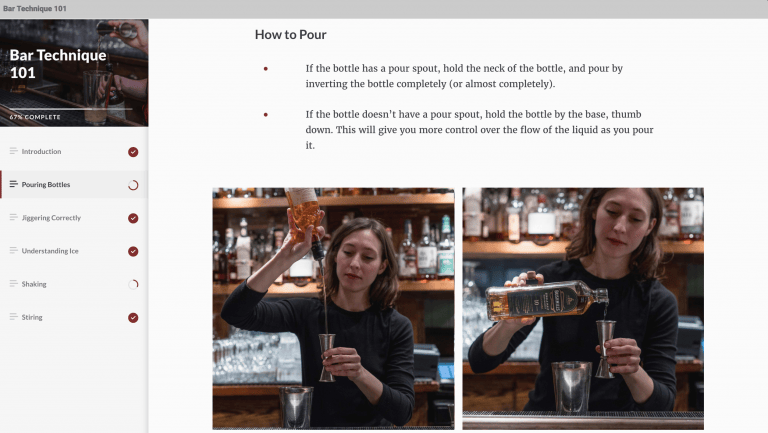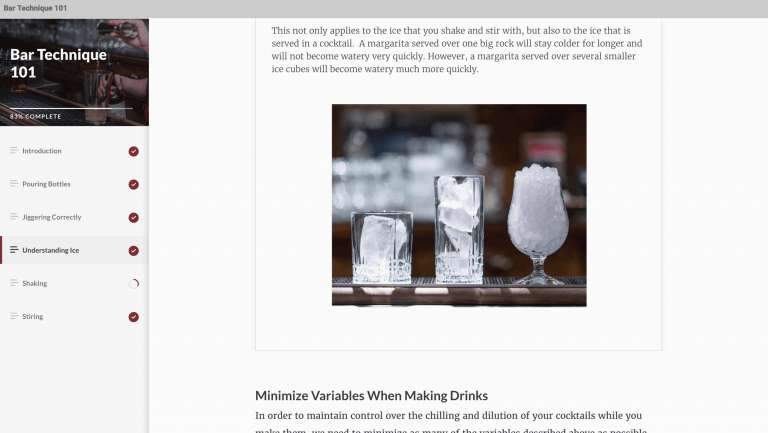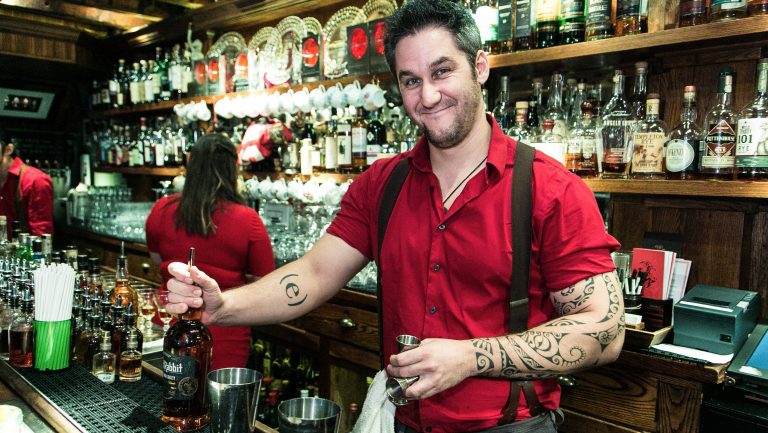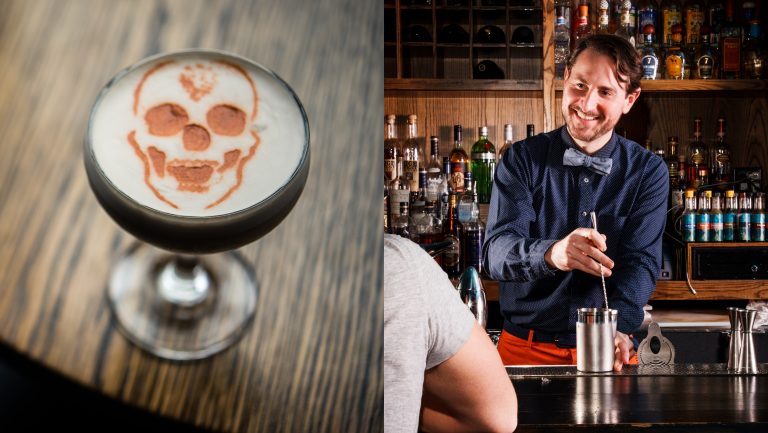The list of awards claimed year after year by Jack McGarry and Sean Muldoon’s New York City bars—The Dead Rabbit Grocery and Grog and BlackTail—may appear to be owed squarely to their cocktail oeuvre, but the best bars are nothing without a team of talented, well-trained, committed employees, and these two acclaimed establishments, which have recently taken their staff-training program to a new level, certainly have that.
Gregory Buda has been working with McGarry and Muldoon for nearly five years. He started as a bartender in 2013, and in 2016 became the director of education for Dead Rabbit and BlackTail, spearheading both bars’ training programs. In addition, he’s been designing a comprehensive online staff-training course to help Dead Rabbit and BlackTail scale up during planned expansions of their bar spaces and an influx of new staffers in 2018.
In Buda’s overarching three-tier educational program, the online course provides the foundational knowledge needed to excel in a front-of-house position at Dead Rabbit or BlackTail. It’s designed to be taken over a nine-month period after employees complete the first tier of the program—an introductory three-month apprenticeship.

Don’t miss the latest drinks industry news and insights. Sign up for our award-winning newsletters and get insider intel, resources, and trends delivered to your inbox every week.
The course consists of a series of lessons with corresponding instructional photos and videos, all created by Buda (who is a photographer on the side). At the end of each lesson, employees take a quiz to evaluate what they’ve learned and pinpoint any areas where they may need improvement. The third tier of the program features one-on-one instruction to help employees hone their skills and address any trouble spots; it includes master classes and tastings.
Buda’s teaching philosophy embraces the idea that “if you understand the why behind something, you understand it.” In addition to lessons focused on bartending techniques, the online course provides employees with an elemental understanding of spirits production. Buda says that providing this type of structured education means the difference between employees who recite rote facts and staff who are able to convey a deeper level of understanding to customers. It also sets employees up for success.
“We’re putting in place a system not just to facilitate training,” says Buda, “but to really define what these [front of house] positions are—and what you need to do to reach the next level.” It’s an investment of time and resources that he, Muldoon, and McGarry agree is essential. “If you invest in your staff,” says Buda, “your staff will invest in your business.”
Here are Buda’s tips for creating an education program that meets the complex needs of a growing bar business.
1. Evolve your training technique along with your staff.
While most serious cocktail bars offer some kind of training period, Buda has found that staff education needs to keep step with future expansion—as your staff grows, so should your staff-training technique.
“We have what started as kind of a mom-and-pop shop at Dead Rabbit,” says Buda, explaining that in the beginning, he and McGarry and Muldoon had a very small team of people, but that they now have 68 front-of-house employees working in the two bars. “[It’s] a growing group of people who need to be managed and trained in various positions at various levels—across two different venues.”
Implementing a comprehensive online training course puts systems in place and the core information in writing, which makes that material available to any employee who wants to read it. “It’s told in the right way with the right voice in the right context,” says Buda, “and it won’t vary based on the person who’s relaying that information to a staff member.”

2. Provide detailed but concise instruction.
It’s important to identify the right amount of information to convey in a staff-training program. Too much is overwhelming. “I could give three or four books on every category of spirits to have my staff read,” says Buda. “But would they get anything out of that amount of detail, or would it just be so much that it would it all get lost?”
On the other hand, giving too little information—or as Buda calls it, the encyclopedia method, where you provide a fat paragraph on Irish whiskey and it ends there—isn’t nearly enough. Buda’s goal in creating the online course was to write detailed yet concise descriptions that would cover the basics of spirits history and production, the styles of the spirits commonly used at the two bars, as well as how to use the spirits in cocktails, how to build drinks by order and by round, and strategies for menu development. Doing so, he felt, would give the entire staff a good working base of knowledge that they could draw on when explaining to customers what it is they’re selling.
The current edition of Buda’s online study program is more than 200 pages, broken down into more than a dozen 5- to 15-page modules covering every spirits category. It also includes a primer on wine and beer. “It’s enough detail to answer [the staff’s] questions, but [not] a book—or two or three books—of information that’s way beyond what anyone would [expect] in the setting of the bar.”

3. Augment your program with individualized instruction and advanced training.
The online training course is an efficient way to cover a lot of ground. “[It] frees me and the other managers up to pursue the third part of the training program,” says Buda, which focuses on mentorship and one-on-one coaching, as well as tastings and master classes ranging from deep dives into individual spirits to lifestyle-betterment lectures—for example, how to handle your finances if you work in a tips-based occupation, and how to maintain good health in what can be a stressful position.
With Buda’s three-tier program, an employee who displays in-depth spirits knowledge but may need to improve some aspect of bartending technique can get individualized attention. The program is not only a time-saver but a way to more quickly discover where employees need to hone their skills.
They tackle the foundational information in the self-study portion of the program, see what makes sense and what doesn’t, and then take a quiz to identify any shortcomings. “It’s not like you get fired if you fail [a quiz],” says Buda. “The idea is you [can] see where you went wrong.” It also gives management a chance to address the things that may be challenging for someone.
“Now we can go one level deeper than that basic information and get into the nitty-gritty of it,” says Buda. “That’s the idea behind [this education program]—it automates the easy stuff so that we can spend more personalized time on the more difficult and challenging stuff.”


Dispatch
Sign up for our award-winning newsletter
Don’t miss the latest drinks industry news and insights—delivered to your inbox every week.
Amy Zavatto is the author of Prosecco Made Me Do It: 60 Seriously Sparkling Cocktails, Forager’s Cocktails, and The Architecture of the Cocktail. Her stories appear in Liquor.com, Imbibe, Beverage Media, and many others. She judges at the American Craft Spirits Association annual competition and the New York Wine & Food Classic, and she earned her Level III Certificate from the Wine & Spirits Education Trust, but her favorite way to learn is through taste and travel. She’s a big fan of underdogs and talking with her hands.






